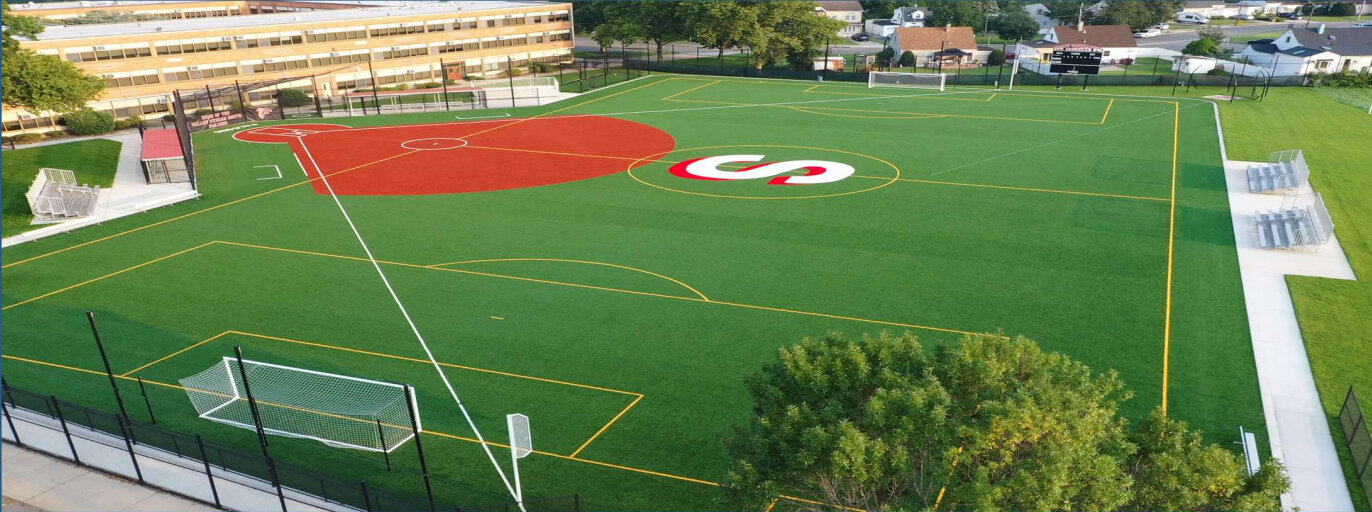See why Valley Stream Central High School District coaches are raving about new $5.9M turf fields
Long-delayed renovation is finally here.
Four years ago, public school districts nationwide were flush with federal cash. The billions of dollars was meant to bring schools back from the ordeal of the pandemic. Some districts in dire need used that funding to plug up major financial holes or shore up basic infrastructure. But others like the Valley Stream High School District saw an opportunity.
With voters’ blessing, the district channeled this large infusion of cash into big-ticket projects budgeting for new smart lockers, mental health clinic renovations, a new barbering program — the list goes on. Students are already benefiting from the completion of several of these projects but many are still under construction or have yet to move past the planning stage.
Thomas McDaid, assistant superintendent for finance and operations, updated families on the progress of each project earlier this month. One project has been a considerable home run for student-athletes and coaches: the completion of two $5.9 million artificial turf fields at North and South high schools, respectively.
Valley Stream North’s varsity baseball head coach, Phil Sanfilippo, says the turf surface will doubly serve his athletes and North’s soccer teams. The cause for the hype mainly comes from one principal advantage turf has over conventional well-worn grass fields — its resistance to downpours.
When heavy rain mixes with earth, muck and mud can make the field unfit to play. And the clean-up can be equally as strenuous and time-consuming.
More practice, better play, and fewer rainouts
“A lot of it is just a matter of waiting and just hoping that the weather changes, that the humidity drops and the clay ground dries up,” said Sanfilippo. “From a coach’s perspective, we can now spend more time focusing on teaching skills and fundamentals of baseball and less time worrying about the field being prepared.”
A muddy field could translate into hours or sometimes days of lost practice time.
“The high school baseball season is only 10 weeks, so you’re talking about 60 practices, scrimmages, and games out on the field,” said Sanfilippo. “There are only so many days of practice time on the field. The turf field allows you to consistently get on the field.”
Valley Stream athletic officials claim the new turf field not only allows for more practice time but also enhances overall playing performance and safety.
The turf installation, argues Sanfilippo, provides athletes with more secure footing, reducing the risk of slipping as they dash to home plate. Improved traction may also give athletes an edge in speed and power. The jury is still out on whether the new fields will reduce student injuries this year, and if they do, how much of the decline can be attributed to the upgraded turf.
And despite its many purported benefits, the new turf is not without its potential downsides.
Unlike natural grass, artificial turf tends to trap heat, increasing the risk of friction burns for athletes, especially during the hotter months. But whatever drawbacks for players and maintenance crews, the switch to synthetic fields more than makes up for it in its durability and resistance to the whims of Mother Nature. Deeangelo Guevara, Valley Stream North Athletic Director, is already seeing improvements in scheduling practice times and games for athletes.
“Scheduling is a lot easier for us and a lot more free flowing,” he said. “Teams have (more consistent) access and we don’t have to kind of stop the team from practicing or lower the quality of practice due to the quality of the infield.”
Have an opinion on this article? Send an email to jlasso@liherald.com.






